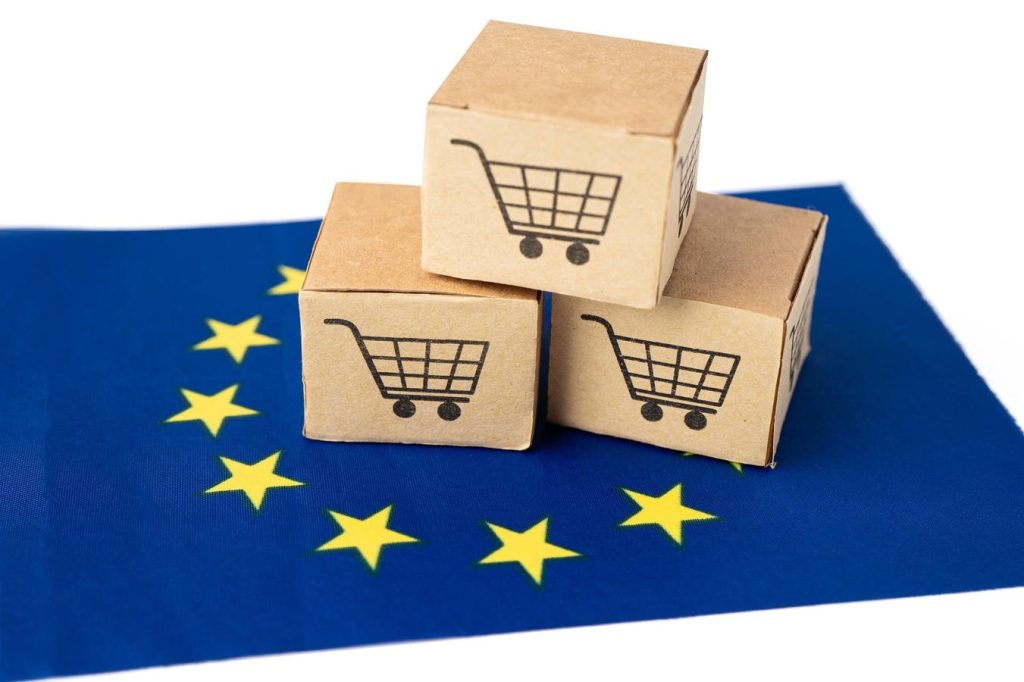When it comes to cross-border sales into the European Union (EU), understanding value added tax (VAT) regulations can be complex yet crucial for compliance and efficient operations. Many non-EU traders struggle to understand when VAT should be charged and how VAT interacts with customs regulations. Making mistakes can be costly and have unintended consequences. If a seller collects VAT that they should not collect or is unaware of their tax compliance obligations altogether, the customer may be faced with an unexpected tax bill which will lead to reluctance to make future purchases. This article provides a clear and simple explanation of how VAT applies to e-commerce sales of goods shipped to buyers in the EU from outside the EU.
VAT and e-commerce sales: two key components
When an e-commerce seller ships goods from abroad to customers in the EU, two “VAT-relevant” events occur: the sale and the importation. This can be confusing for sellers, especially those unfamiliar with the VAT system, who may view the transaction as a single sale. However, VAT laws distinguish between selling goods and importing goods into the EU. As we will see below, VAT may be due on one or both of these events. We will refer to the VAT due on the sale as “domestic VAT” and to the VAT due on the importation of goods as “import VAT”. In the rare case of exempt goods, VAT is not due on either event, but this scenario is exceptional and will not be discussed further.
Import VAT: taxing goods at the EU border
Import VAT is a tax levied on goods imported into an EU country from a non-EU country. This tax ensures that imported goods are taxed similarly to locally produced goods, maintaining fair competition within the EU market. Import VAT is typically calculated based on the combined value of the goods, including shipping costs, insurance, and any applicable customs duties.
Import VAT is due when goods enter the customs territory of an EU member state. The responsibility for paying this tax usually falls on the business importing the goods, typically the person presenting the goods to the customs authorities. Depending on the agreed International Commercial Terms (Incoterms), the importer can be the seller, the buyer, or a person appointed by either of them, provided they are established in the EU. This legal restriction means that a non-EU business without any establishment in the EU cannot act as the importer and pay import VAT. If the importer is VAT-registered, import VAT may be reclaimable as input tax through their VAT returns.
Although import VAT is not due at the point of sale, sellers who handle the importation but are not eligible for input tax deduction may choose to pre-collect import VAT during the online checkout process. This approach allows the collection of the sales price and all related taxes in one transaction, simplifying the purchase for customers. However, pre-collecting import taxes carries certain risks. Sellers who opt for this method must clearly specify that the collected amount is not a tax obligation related to the sale but rather a preliminary payment for taxes due upon crossing the border. In other words, sellers should avoid listing VAT as an invoice line item when pre-collecting import VAT. If they do, the erroneously charged tax may need to be remitted to the tax administration, and import taxes would still have to be paid at the border.
To summarize, when goods enter the EU territory, import VAT is due and must be paid to the customs authorities. Depending on the delivery terms, e-commerce sellers may either make their customers responsible for import tax payments or assume this responsibility themselves. If the seller acting as the importer is VAT-registered, import VAT does not constitute an extra cost as it can be deducted in their VAT return. However, if the seller cannot deduct import VAT, they may opt to recoup this cost by pre-collecting it at checkout.
Domestic VAT: taxing sales within the EU
Domestic VAT is a tax levied on the sale of goods within an EU country. When the seller acts as the importer, they must also manage domestic VAT on the sale of the goods they import into the EU. This is because the transaction converts into a domestic sale after importation, requiring compliance with local VAT regulations. Domestic VAT is applicable at the point of sale, meaning the seller must add VAT to the price and display it on the invoice issued to the buyer. Being responsible for domestic VAT necessitates the seller’s VAT registration in the respective EU country.
If the customer acts as the importer, domestic VAT does not need to be charged on the sale. In this scenario, the only VAT that applies to the transaction is import VAT.
Incoterms and VAT responsibilities
The responsibility for the importation of goods is often determined by the Incoterms agreed upon by the buyer and seller. Published by the International Chamber of Commerce (ICC), Incoterms provide standardized rules that define the responsibilities of sellers and buyers in sales contracts. There are eleven Incoterms, covering various commercial aspects, including transportation responsibility, insurance obligations, and customs clearance duties. To illustrate how Incoterms affect VAT compliance obligations, two commonly used Incoterms are explained below.
Delivered Duty Paid (DDP)
One commonly used Incoterm is Delivered Duty Paid (DDP), where the seller assumes maximum responsibility. Under DDP terms, the seller delivers goods to the buyer’s specified location, handles all customs clearance, pays for import duties and VAT, and assumes all associated risks until the goods reach their destination.
From the buyer’s perspective, DDP is ideal as the goods are delivered to the final destination with all transport and customs formalities handled by the seller. This provides a clear, all-inclusive price, enhancing transparency. By managing customs clearance and import taxes, sellers simplify the process for consumers, leading to a better customer experience.
However, while DDP terms can enhance client satisfaction by offloading all complex responsibilities from the buyer, they pose significant challenges for the seller. Sellers must ensure compliance with import regulations, including the classification and valuation of goods, proving their origin, and completing customs declarations. These tasks add complexity and elevate operational costs. Sellers may not always be able to fulfill these tasks, especially if they are not established in the EU.
Delivered at Place (DAP)
Under Delivered At Place (DAP) terms, the seller is responsible for delivering the goods to a specified place agreed upon with the buyer. The seller bears all risks and costs associated with transporting the goods to the named place of destination. However, the buyer handles import clearance, including paying any import duties and taxes. By transferring the responsibility for importation to the buyer, DAP reduces the administrative burden and complexity for the seller. Unlike DDP, DAP does not require the seller to register for VAT in the EU or to charge domestic VAT on the sale.
While using the DAP Incoterm offers significant benefits, such as clarity and convenience for the seller, it can sometimes negatively impact the customer experience. Under DAP terms, the buyer is responsible for paying customs duties and taxes upon the arrival of the goods. Customers may be unaware of these additional costs, leading to dissatisfaction and a perception of hidden fees. The total price the consumer ends up paying can be significantly higher than anticipated due to customs duties, import VAT, and other charges, which can lead to negative reviews or reluctance to make future purchases. Additionally, consumers are required to handle the customs clearance process, which can be complicated and time-consuming. Any issues or delays in customs clearance can result in longer delivery times, frustrating customers who expect quick and seamless shipping experiences.
Conclusion
Understanding the distinctions between import VAT and domestic VAT is crucial for businesses engaged in cross-border sales to the EU. While this article explained how both operate in the simplest scenario, the reality of cross-border e-commerce is far more complex. To structure their operations efficiently, traders should consider regimes such as postponed accounting, customs warehouses, fiscal representation or Import One Stop Shop. Additionally, sellers should stay informed about relevant developments, such as the proposed EU customs reform that will affect importation procedures.
Choosing the right Incoterms necessitates careful evaluation of several factors, including the nature of the goods, the logistics network, and the legal complexities involved in the transaction. While DDP may appear advantageous for fostering good relationships with buyers, it often presents significant challenges for sellers, such as VAT registration requirements, handling import procedures, and increased financial risks. Alternatives like DAP provide a more balanced approach, distributing responsibilities more evenly between sellers and buyers.
The opinions expressed in this article are those of the author and do not necessarily reflect the views of any organizations with which the author is affiliated.
Read the full article here










